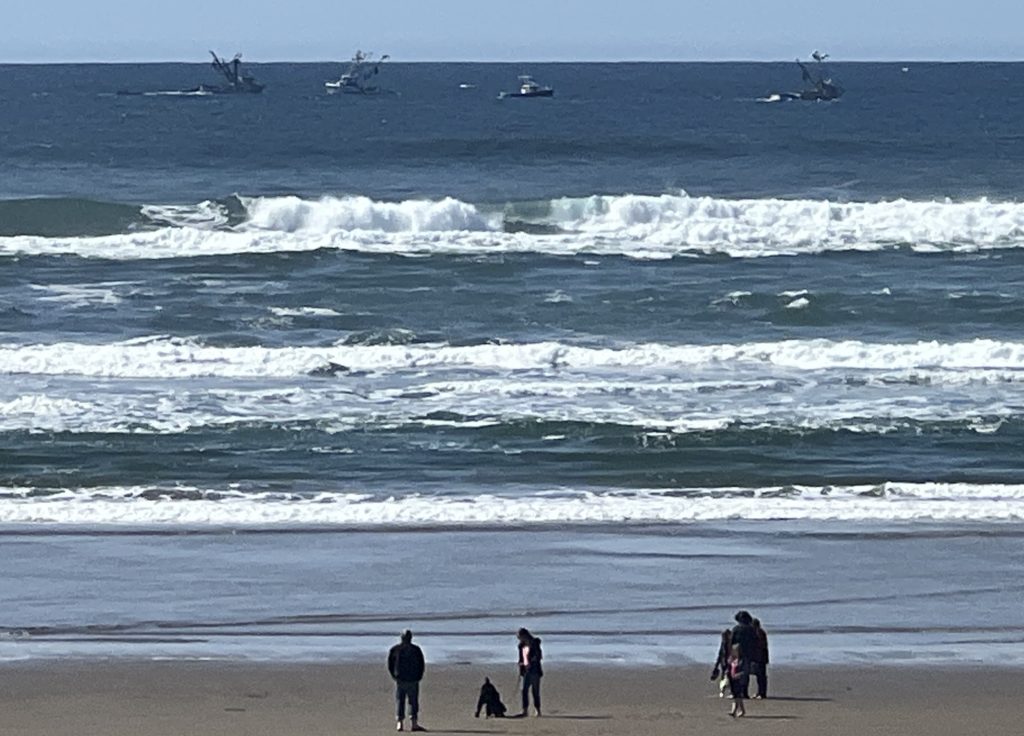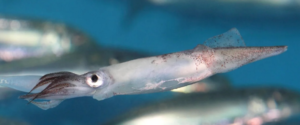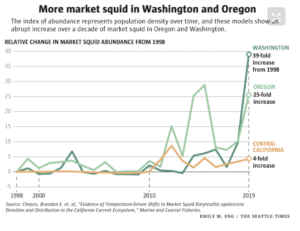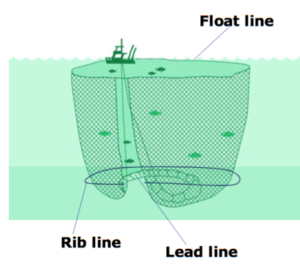
By DANA TIMS/YachatsNews.com and NICHOLAS TURNER/The Seattle Times
Those brightly lit boats working just off offshore can mean only one thing – market squid have just returned to Oregon’s coastal waters.
The lights, used for night fishing, transfix the small, fist-sized squid, which are then rounded up in nets.
The commercial viability of the market squid fishery, which has been building since 2016, is also on clear display as increasing numbers of boats are looking to cash in on the action.
“It’s too soon right now for us to have any reliable numbers,” said Troy Buell, fishery management program leader with the Oregon Department of Fish & Wildlife. “But it’s clear that quite a lot of activity is going on.”

New research indicates that marine heat waves caused by climate change are drawing market squid north from their traditional home off California. With no end to that trend in sight, Oregon is now moving to add more regulations to the ones it adopted last March.
Those include taking the first steps to establish long-term limits on the number of boats that can fish for market squid, as well as limiting the sizes of nets that can be employed.
Currently, the market squid fishery in Oregon is an “open-access fishery, meaning there are no limits on the number of vessels that can participate.
The prospect of capping participation is driven by numbers of boats that have increased from the 14 vessels that fished for market squid in 2016 and 2017 to the record 57 that took part last year, according to state records.
Already in place are mandatory two-day-a-week closures to allow market squid the ability to spawn, and a ban on using lights to draw squid out of marine coastal reserve areas.
It’s the science that is driving the discussion, Buell said, and that research points to more and more market squid populating the waters off Oregon and Washington than ever before.
New study pinpoints changes
Marine heat waves driven by climate change have fueled a dramatic increase in market squid along the Oregon and Washington coast over the past two decades, new research shows.

Market squid from central California to northern Washington saw a fivefold increase over the past 22 years, according to a report published by the American Fisheries Society last month. But the largest swells were seen in Oregon and Washington, where models showed each state respectively saw a 39-fold and 25-fold increase in population density of squid during the examined time frame.
It’s not clear yet whether the trend is temporary, or how it will affect coastal communities and the rest of the ecosystem. But the ecological and economic implications are significant, scientists say, and the answers might help them better understand the mechanics of climate change, and more accurately predict the impacts of warming ocean temperatures on aquatic life.
Marine heat waves — otherwise known as “blobs” — can tip the intricate balance of an ecosystem off kilter, and have done so multiple times in recent years along the Pacific Coast.
“With this study, it was the first time we were able to see how the squid would respond during extreme warming events, like the marine heat wave,” Mary Hunsicker, one of the study’s lead authors and a scientist at the Northwest Fisheries Science Center of the National Oceanic and Atmospheric Administration, told the Seattle Times recently. “We know with climate change and warming temperatures coupled with increasing variability in the climate patterns, we’re going to see more of these extreme events.”

The study, which was led by researchers from NOAA, Oregon State University and the University of California at Santa Cruz, used data collected between 1998 and 2019 by the National Marine Fisheries Service and created a model to estimate changes in the population density and distribution of market squid along the Pacific Coast.
What they found is that the uptick in squid population density was noticeable in warmer, saltier waters but more pronounced in areas undergoing unusually high temperatures.
The primary culprit of this “squid bloom” — as one researcher put it — is a warming ocean.
“It appears these increases are strongly associated with marine heat waves and that the expansion is occurring across the entire northern California to Washington border but fastest in these northern strata,” said Brandon Chasco, a scientist at the NOAA Northwest Fisheries Science Center and another author of the report.
Temperature changes not new
Irregular or unpredictable changes in surface temperature are hardly new in this part of the Pacific Ocean.
The El Niño Southern Oscillation is a climate pattern that triggers a warming and cooling cycle — El Niño and La Niña, respectively — every two to seven years in the eastern Pacific. Every cycle has a significant impact on ocean temperatures, currents, coastal fisheries and the weather.
Marine heat waves, however, are a more contemporary phenomenon.
Since 2014, multiple marine heat waves have occurred along the Washington coast. These “blobs,” as they’ve been called, are pools of water that can be warmer by 1 to 2 degrees Fahrenheit at the edges and up to 5 degrees at their centers.
A 2016 study by then-University of Washington doctoral student Hillary Scannell found that marine heat waves have increased in frequency since the 1970s.
The first blob on the Pacific Coast in 2013 spanned an area of the Pacific Ocean larger than the continental U.S. for 17 months with a surface temperature 2.7 degrees Fahrenheit above normal. Research at the time predicted these blobs would reoccur naturally every one to five years.
Then, in late 2019, another one emerged on the West Coast.
Marine heat waves can distort the intricate balance of an aquatic ecosystem and have a devastating impact on wildlife.
The 2014 marine heat wave was most likely the cause of a massive die-off of more than 62,000 common murres — a fish-eating North Pacific seabird — according to a report published in January 2020.
The report estimated the total death toll was closer to 1 million birds, since only a small portion typically wash ashore after dying at sea.
Squid respond to change
California market squid, or Doryteuthis opalescens, reproduce quickly and don’t live long. Adults can reach up to 12 inches long and they have an abundance of both predators and prey. This makes them highly responsive to environmental changes and a key part of the food chain.
The market squid lives up to one year, and its habitat spans eastern Pacific coastal waters from Mexico to Alaska.
“The question is, how does that balance out?” said Caitlin Akselrud, an expert on California fisheries and a doctoral candidate at the University of Washington’s School of Aquatic and Fishery Sciences. “I personally don’t know the answer to that question.”
Akselrud’s research focuses on developing models to predict market squid abundance.

By volume, market squid account for the largest fishery in California. As they became increasingly abundant farther north along the Pacific coast over the last 20 years, fisheries in Oregon rushed to take advantage.
According to the Pacific Fisheries Information Network, squid harvests in Oregon went from zero in 2015 to 1,260 metric tons in 2016 and a record 4,667 tons in 2020. The revenue for that fishery jumped from $1.1 million dollars in 2016 to almost $6 million in 2020.
Squid harvests in Oregon went from almost nothing half a decade ago to more than 10 million pounds last year. In 2021, the state adopted its first regulations on fishing for market squid.
Washington fisheries, however, have been slower to bite.
Barely anybody is engaged commercially in market squid in Washington, according to Lorna Wargo of the Washington Department of Fish and Wildlife. The handful of Washington vessels that do fish for squid, she said, go down to Oregon or California where there is infrastructure that allows for squid to be processed.
“A fishery just hasn’t developed, even though there’s indication that squid abundance has increased,” Wargo said.
Scientists hope more research into ocean temperature and salinity as functions of biodiversity could help in the development of an “early warning system” that could be used by coastal fishing communities to predict changes in the population of market squid.
“We don’t have a good grasp on that yet, but we’re definitely expecting these shifts to have impacts on fishing communities and other animals in the ocean,” Hunsicker said. “What we’re really trying to do is get more at the mechanisms that are driving these shifts.”
- Dana Tims is an Oregon freelance writer who contributes regularly to YachatsNews.com. He can be reached at DanaTims24@gmail.com
- Nicholas Turner is a Seattle Times reporter who can be reached at nturner@seattletimes.com


